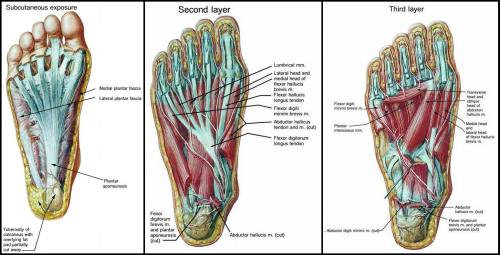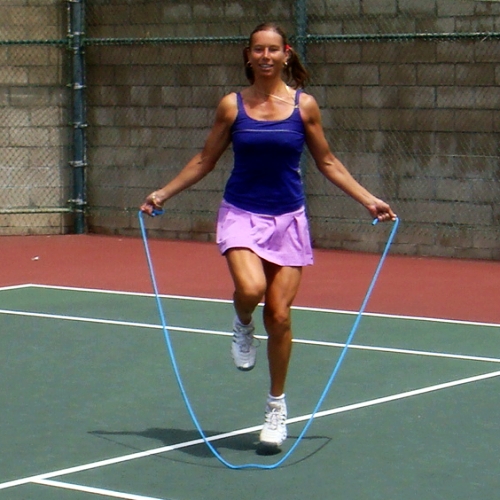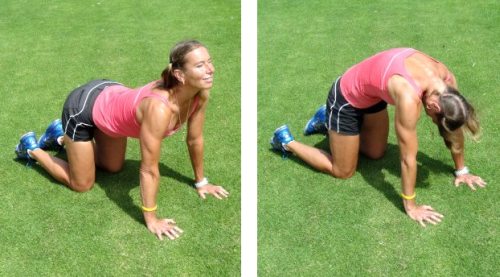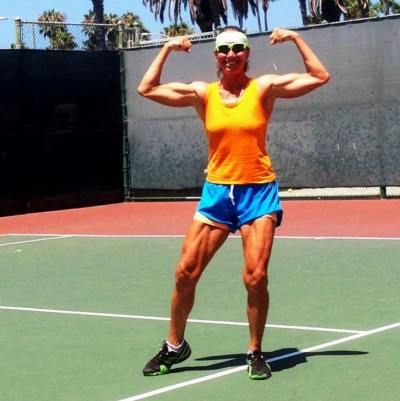It’s All about the Feet
Our feet have many nerve endings that collect data on pressure, temperature, and terrain if we are walking barefoot. Wearing shoes limits these inputs and the balance and mobility is less natural and can increase the risk of falls, ankle sprains, and other injuries. Lately, there has been a lot of movement toward minimalist footwear (such as Vibram’s FiveFingres shoes) and a lot of books on barefoot running. Obviously, that is not something a tennis player would want to do, especially when playing on hard courts. A few players state that playing in minimalist footwear on clay or grass is an amazing and healthy experience, but for the rest of us, we need to take care of our feet in a different way.
Extrinsic and Intrinsic Feet Muscles
Any imbalances in musculature in your feet will limit full range of motion and alter your running and walking gait, which in long term can cause problems and overuse injuries. There are two kinds of musculature in your feet, extrinsic and intrinsic:
1) Extrinsic foot muscles have one attachment in the foot and the other one somewhere up in the leg. These muscles move your foot relative to the lower leg. The three muscles of the calves are all extrinsic.
2) Intrinsic foot muscles have both ends inside the foot. Intrinsic motions move one portion of the foot relative to other foot joints. One example is the muscle (abductor digiti minimi) that moves your pinkie toe out and away from the other toes.
For the feet muscles, wearing shoes is like putting a cast on your arm after a bone break: without regular use, the muscles atrophy quickly. When the smaller intrinsic muscles with fine motor skills atrophy, the larger extrinsic muscles start to compensate. Slowly, they are overused, developing trigger points and tension that will further cause more problems.
Training Your Feet
The muscle groups of your two feet make up 25% of the body’s muscles. If you ignore the strength and function of your feet muscle, it is like eliminating upper-body exercises from your routine. That doesn’t sound too good, does it? Yet, it is very common that we don’t pay enough attention to our feet.
Exercises that innervate the intrinsic foot muscles and restore the length of lower leg muscles are extremely important. Foot strength has the key role in proper foot mechanics, gait patterns, ankle stabilization, and whole-body balance.
Your toes are designed to have as much dexterity as your fingers — each toe joint can flex and extend, abduct and adduct. These are basic, simple motions, but when you try it yourself, you realize how difficult it is to lift one toe without lifting the other toes. That’s why you need to start a strengthening program for your feet, and work on it until your movements are fluid and the motor skills are visibly improved.
Toe Lifts
 Lift your big toe on its own, without the other toes lifting. Keep working on it until you are capable of doing it smoothly.
Lift your big toe on its own, without the other toes lifting. Keep working on it until you are capable of doing it smoothly.
Process to lifting each toe one at a time, until they are all in the air. Then, reverse and place them down again, starting with the 5th (smallest) toe, until you get your big toe.
Toe Abduction
Our feet are always smashed and compressed inside our shoes, often too narrow for the toes to move. The narrow toe space in footwear creates weak toe abductors and tight adductors, which prevents your toes from spreading wide naturally.
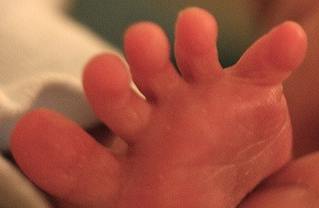 Stand up barefoot, with the weight on your heels so you can lift your toes. Now spread your toes away from each other without lifting them off the ground.
Stand up barefoot, with the weight on your heels so you can lift your toes. Now spread your toes away from each other without lifting them off the ground.
If you wear flip-flops as footwear of your choice when you are not in the tennis shoes, you need to know that flip-flops force your toes to increase the gripping action, which can cause chronic tension in the flexed position and eventually alter your balance.
Stretching the Toe Flexors
Stand up and reach one leg behind, placing the top of the foot on the ground. Relax and stretch your ankle. If you experience cramping in your toes, take a break and return to the stretch. Work yourself up to holding 1 minute on each side.
Strengthen Bottom of your Feet
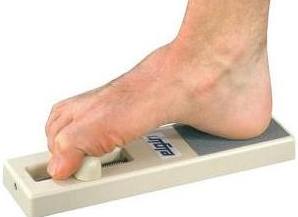 In this exercise, you can either use small pebbles that you will pick up with your toes, one by one, from the ground. You can also use a towel that you will scrunch with your toes. Try to feel the muscles in the bottom of your feet. If you would prefer a simple, yet very effective tool for exercising your feet muscles, get yourself the Elgin’s Arch Exerciser that will make it simple to strengthen the muscles and also helps to prevent plantar fasciitis and heel spurs. You can find the exerciser on many websites or stores, but I often find Amazon’s prices the most affordable.
In this exercise, you can either use small pebbles that you will pick up with your toes, one by one, from the ground. You can also use a towel that you will scrunch with your toes. Try to feel the muscles in the bottom of your feet. If you would prefer a simple, yet very effective tool for exercising your feet muscles, get yourself the Elgin’s Arch Exerciser that will make it simple to strengthen the muscles and also helps to prevent plantar fasciitis and heel spurs. You can find the exerciser on many websites or stores, but I often find Amazon’s prices the most affordable.
Foot Circles and Points with Therabands
Many foot problems happen because of the limited range of motion or flexibility in the ankle and surrounding muscles. The simple, restorative Foot Points and Circles will create more movement in your ankles and bigger range of motion. To bring this exercise a bit further and work with some resistance, take a Theraband (or any resistance band of your choice) and loop it around your foot. Pull on the band to create enough challenging tension, and do 20 points and flexes, followed by 20 circles clockwise, and 20 circles counter clockwise. You will definitely feel the muscles working. Then repeat for the other foot. If you find one foot much weaker, repeat on the weaker side one more time, until you get both sides evenly strong.
Walking Barefoot
Occasionally, you may want to walk around barefoot or in minimalist footwear, so you would exercise the muscles in your feet during body movement. You will feel the ground differently; you will create a new sense of balance and develop a light foot strike, which will help you to move lighter on the tennis court.
Rehab of your Feet
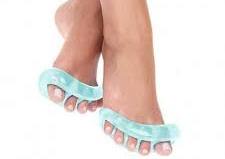 Give your tired and beat-up feet more love. Besides strengthening and stretching, massage them occasionally, give them a hot bath, and soak them in good lotion or shea butter. If you suffer from hammertoes or other toe issues, or if you are in your tennis shows for many hours each day, you could use this simple device “Pampered Toes” to give your toes a little bit extra room. You can use it just for a few minutes a day, yet it will make big difference in your feet’s well-being. You can also roll your feet on a golf ball or other small massage balls.
Give your tired and beat-up feet more love. Besides strengthening and stretching, massage them occasionally, give them a hot bath, and soak them in good lotion or shea butter. If you suffer from hammertoes or other toe issues, or if you are in your tennis shows for many hours each day, you could use this simple device “Pampered Toes” to give your toes a little bit extra room. You can use it just for a few minutes a day, yet it will make big difference in your feet’s well-being. You can also roll your feet on a golf ball or other small massage balls.
![]()
After only a few weeks of strengthening your feet muscles, you will notice a better movement on the tennis court, and if you have been experiencing aches in your knees, or tightness in your calves or glutes, you may be surprised that these will go away. Make sure to give your calves a good stretch and myofascial release regularly!
Keep your feet fit and happy, and your tennis game will blossom too!
![]()
PART 2 to Strong Feet: stretch your hip flexors to improve the mobility in your ankles.

